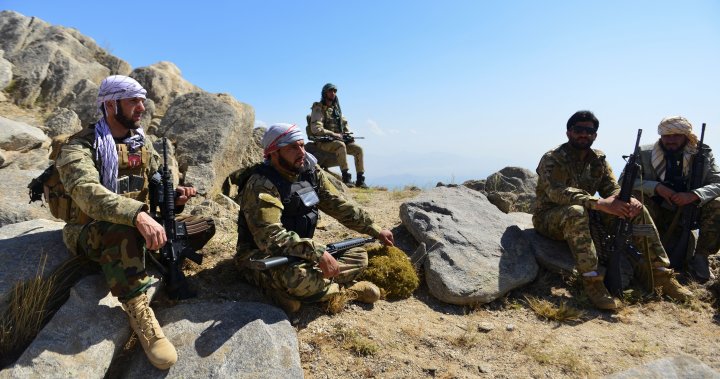Afghanistan’s anti-Taliban resistance is growing. Is it enough to retake the country? – National | Globalnews.ca
The anti-Taliban resistance movement is growing in Afghanistan, but experts aren’t convinced they can retake the country.
The National Resistance Front of Afghanistan, also known as the Panjshir resistance, has been making waves after seven Taliban fighters were killed attempting to enter the Panjshir valley earlier this week.
The military group, comprised of former Northern Alliance and anti-Taliban fighters, was formed in August after the Taliban overtook Afghanistan in a stunning week-long rout that saw seven people die rushing to the tarmac of Kabul’s international airport in a desperate bid to escape.
The NRF is run by Ahmad Massoud, son of a former Mujahideen commander and former Afghanistan vice-president Amrullah Saleh.
Read more:
‘We need your solidarity’: What the Taliban takeover means for Afghanistan’s women and girls
On Wednesday, the Taliban said it had the group surrounded and called on them to negotiate a settlement. According to experts, no resistance movement inside the country stands much of a chance.
“I don’t think there will be successful anti-Taliban resistance movement at all,” said, Erika Simpson, president of the Canadian Peace Research Association.
U.S. President Joe Biden announced he would begin withdrawing American troops from Afghanistan in April. The U.S. flew its last soldier out on Aug. 30, ending the country’s longest war that spanned two decades.
When the U.S. began withdrawing its troops, Simpson said the U.S. withdrew equipment that helped support the Afghan National Defence Forces, which helped prevent the resistance from fighting a high technology war.
But Simpson, who is also an associate professor of international relations with Western University, said this could have actually given the Taliban, which are typically a low-technology group, an edge.
If an anti-Taliban resistance movement is to pick up speed, Simpson debated whether they would have enough arms to topple the Taliban.
“Who would arm them?” she said. “Who would risk it?”

She added that any real resistance would likely come from the hundreds of thousands of refugees who will eventually fight to return to their homes and dismantle the organization that displaced them.
Simpson said it would be smarter to “forget” about trying to arm resistance movements in Afghanistan, and focus on the “resistance movement” happening outside.
Adding to that, Aurel Braun, an international relations and political science professor at the University of Toronto, said even if the NRF have some equipment, they would be desperately short of food, medicine and weapons — “and I don’t see how that would be provided to them.”
Afghanistan is a landlocked country, meaning it is surrounded by land but no oceans, making it difficult to trade. The country also shares borders with Iran, Pakistan, Tajikistan, Turkmenistan, and Uzbekistan, which Braun said would make airlifting supplies “a very difficult task” for Afghanistan.
Even resistance in the form of ongoing protest in Afghanistan may be futile, Nader Hashemi, director of the Center for Middle East Studies at the University of Denver.
Read more:
Hunger crisis looms in Afghanistan under new Taliban regime
“The Taliban is not known for its toleration and moderation,” Hashemi said.
He added Afghan women, who have been at the centre of protests demanding gender equality rights throughout the country, will likely be “repressed very severely, in the way that the Taliban have done in the past.”
The Taliban are in power. What’s next?
What comes next for Afghanistan appears to be a series of hardships, in-fighting and financial woes.
Politically, the Taliban may have to deal with challengers such as ISIS-K, who claimed responsibility for a suicide bombing last week that killed 182 people including 13 U.S. service members at Kabul’s international airport.
ISIS-K is an extremist organization at war with the Taliban, comprised mainly of disgruntled Taliban members, radical extremists from neighbouring countries and leftover remnants of ISIS in Iraq and Syria.
It’s much more extreme, much more radical,” Hashemi said.
“If (the Taliban) wants the type of diplomatic recognition and engagement with the international community that it’s been talking about over the last couple of weeks, it will be dependent on them being able to control the territory of Afghanistan, including controlling and preventing ISIS-K from manifesting itself, from attacking other targets, whether they’re in Afghanistan or a part of Afghanistan.”

Shortly after the Taliban took control of Kabul on Aug. 15, Afghanistan’s president Ashraf Ghani fled the country to the United Arab Emirates. Afghanistan’s ambassador to Tajikistan has since accused Ghani of stealing $169 million from state coffers, while the Russian Embassy claimed he’d escaped with four cars and a helicopter full of cash.
But Simpson said his return is unlikely.
“Ashraf Ghani has no legitimacy or credibility to organize a government in waiting outside Afghanistan. No legitimacy or credibility. People will spit on his grave,” she said.
Simpson also noted that anyone hoping to see the formation of a coalition government may be waiting a long time.
The National Coalition of Afghanistan party is led by Abdullah Abdullah, Afghanistan’s former foreign minister, while former Afghan president Hamid Karzai is also angling for a political role. Simpson said the pair could try to form a coalition with the Taliban but “they don’t have any leverage. They don’t have any bargaining power.”
In the meantime, the Taliban are pushing for international recognition as the country’s official government from the West. Braun said this is to secure aid from the U.S., which the Taliban will need if they hope to stabilize Afghanistan’s economy without significantly increasing taxes.
Read more:
With Kabul airport closed, Afghans fearful of Taliban reprisals rush for borders
According to the World Bank, Afghanistan is one of the world’s top receivers per country of financial aid, rivalled only by Syria, Ethiopia, Bangladesh and Yemen. In 2019, the World Bank said Afghanistan received more than $4.2 billion in international aid, while the country’s GDP remained just over $19.2 billion.
“Foreign aid was crucial in keeping the Afghan economy alive and so they would like to maintain that,” he said.
But for residents who remain in Afghanistan — particularly women and girls — Braun predicted “desperation.”
Braun pointed to emerging reports of residents taking dangerous routes to leave Afghanistan now that Kabul’s airports have closed. There has also been an increase in food insecurity with more people being prohibited from going to work and school, particularly in households where women are the breadwinners.
“Women have been forced to stay at home (from work),” he said. “Once they run out of supplies — ordinary things, household goods and so on, that’s going to be a huge, huge problem.”
The Taliban so far has publicly promised “amnesty” for anyone who fought against them and have said they would allow women to return to work.
But Hashemi said he is “deeply skeptical,” given the Taliban’s prior track record, which saw women barred from working or attending school, forced marriages and banned women from leaving their homes without a male escort.
In addition to this, Hashemi said the country is expected to suffer a massive “brain drain” as educated women, along with interpreters and Western administration staff and their families flee the country in droves.
As a result of U.S. military intervention, Hashemi said a “civil society” was formed. “Millions of Afghan girls and women were able to go to school.”
“There was an intellectual class that emerged,” he said. “Unfortunately, most of that international class has now fled.”
— with files from the Associated Press
© 2021 Global News, a division of Corus Entertainment Inc.
For all the latest world News Click Here




